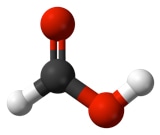Formic acid is also known as methanoic acid. It is the simplest carboxylic acid. The chemical formula of formic acid is HCOOH or HCO2H. It is an important intermediate in chemical synthesis and most notably in some ants. The word "formic" means ant in the Latin word. It is isolation by the distillation of ant bodies for the first time. Anions, salts and esters derived from formic acid are called formates. Formic acid has a highly pungent and penetrating odor at room temperature. It is a colorless liquid and is miscible with most polar organic solvents and water. Formic acid is also soluble in hydrocarbons. It can be found in the trichomes of stinging nettle and the trichomes of stinging nettle naturally. Formic acid can be occurred naturall in the atmosphere due to the forest emissions primarily.

Scientists at Creative Proteomics utilize a highly quantitative method with high-performance liquid chromatography (HPLC) for the determination of Formic acid levels in various samples, including Tissue, Plant, Bacterials, Cells and more. High-Performance Liquid Chromatography (HPLC) using a differential refractive index detector (RID) for the determination of Formic acid levels in a lot of biological samples.
Formic acid can be used as a preservative and antibacterial agent in livestock feed and the using is the major use of formic acid. Formic acid is also can be used to suppress the formation of butyric acid and to promote the fermentation of lactic acid on silage in Europe. Formic acid can cause the fermentation to occur quickly even at lower temperature as a result to reduce the loss of nutritional value. Formic acid can slow the decay processes can make the feed to keep its nutritive value longer. As a result, Formic acid is widely used to preserve winter feed for cattle. Formic acid is also can be added to feed to E. coli bacteria in the poultry industry. Formic acid is also used widely in the production of leather, for example, the tanning consumpte about 23% of the global consumption in 2009. Mineral acids can be replaced by formic acid for various cleaning products, for example oilet bowl cleaner and limescale remover.
Sample Type
Tissue, Plant, Bacterials, Cells and more
Method
High-Performance Liquid Chromatography (HPLC) using a differential refractive index detector (RID) for the determination of Formic acid levels in a lot of biological samples, Tissue, Plant, Bacterials, Cells and more. This Methodology provides accurate, reliable, and reproducible results of Formic acid measurement, which enables us to analyze of Formic acid levels in vitro and in vivo.
Send us your samples, you will get all information that you need!